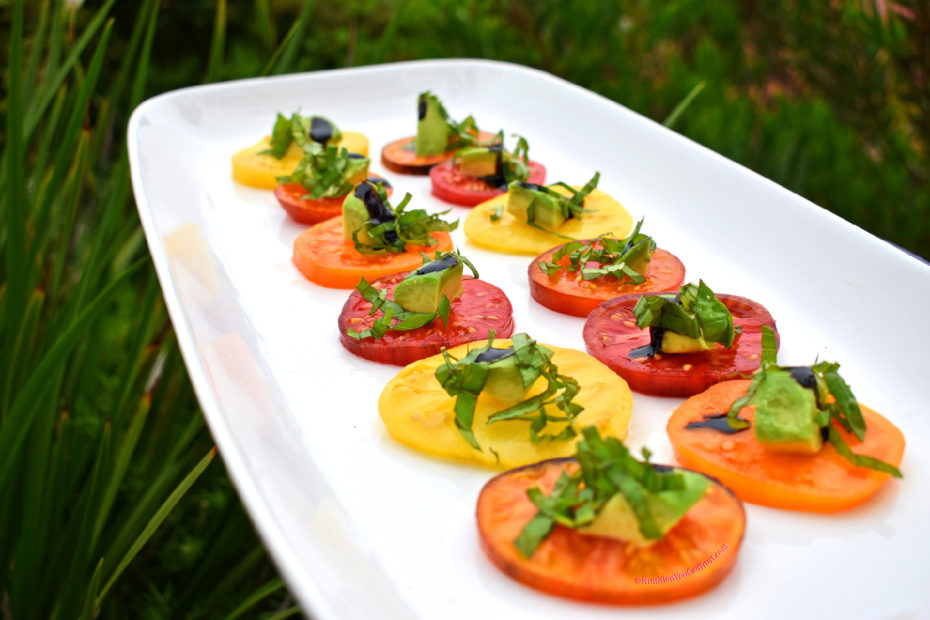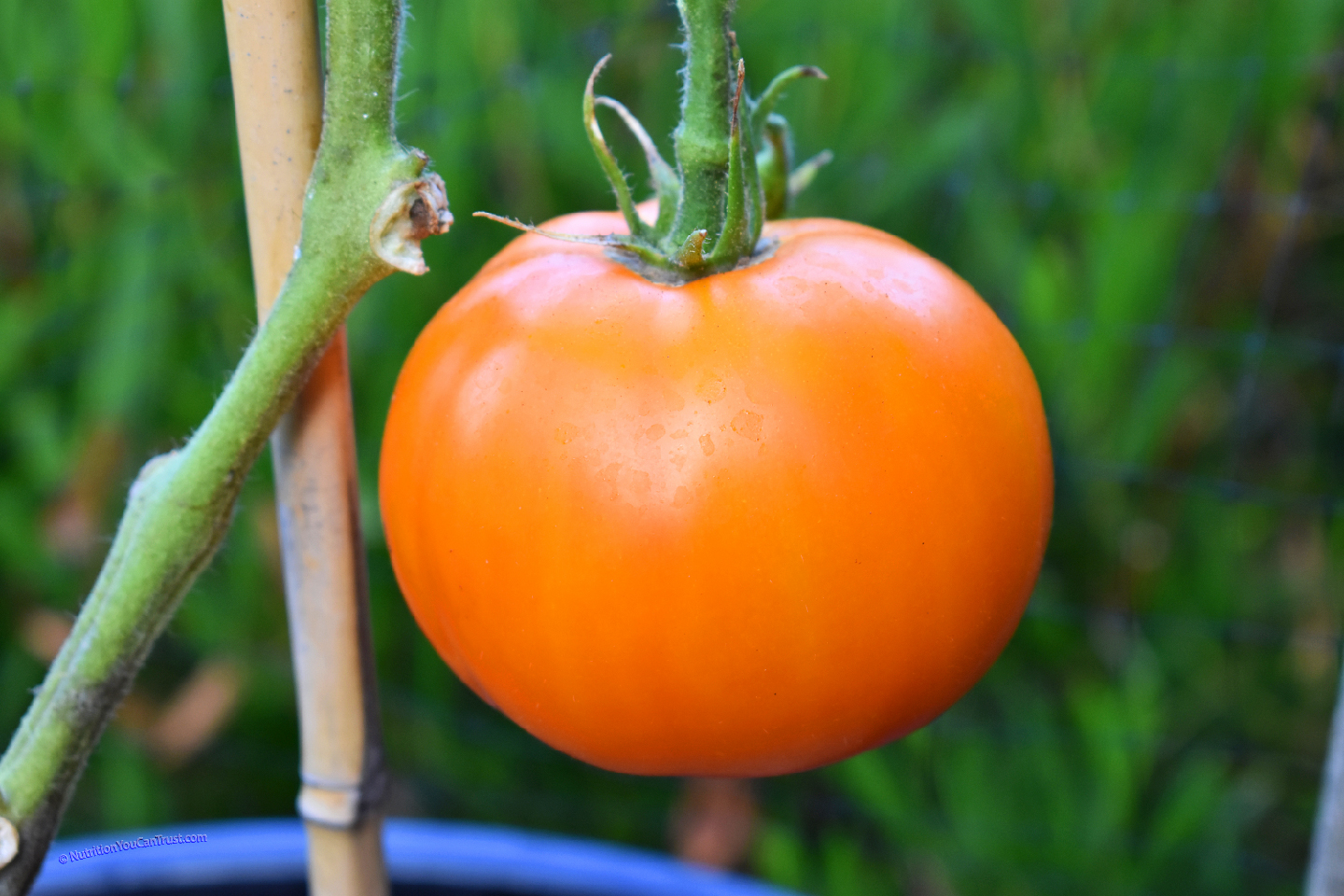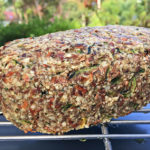Caprese is one of my favorite summer appetizers to make: it’s the perfect combo of sweet tomato, rich and fatty cheese, earthy aromatic basil with a balsamic vinegar kicker.
I’ll typically make caprese two ways: the traditional way with mozzarella cheese (or even burrata), and I like to do a dairy-free version using avocado as a substitute for cheese (also keeps it paleo and vegan-friendly if you follow those food lifestyles). The swap works great because you’re still keeping that fatty bite intact.
I’ve also done a caprese version in the past using seasonal nectarine + burrata + basil (here’s a pic and recipe over on the gram — delicious if you want to switch up the tomato part).
Overall no matter how you make your caprese, it’s a simple, seasonal summer dish that anyone can throw together in 5-10 minutes and serve up with friends and fam… and if you’re growing any summer tomatoes and basil, definitely a bonus adding the garden-to-table elements to the dish and sharing what you’ve grown with your tribe.
The Nutrition You Can Trust we’ll cover in this post:
- organic vs. non-organic (conventional) grown tomatoes: compare of visual, taste, flavor of each + a test you can do at home.
- a few studies on the difference in nutrition properties with organically grown vs. conventionally grown tomatoes.
This version of Caprese is recipe-friendly:
- paleo
- vegetarian + vegan
- dairy-free
- gluten-free
- ReBoot Protocol (week 1-3 – see kitchen notes below)
The Nutrition You Can Trust:
For any caprese dish it’s ideal to get some organically grown heirloom tomatoes vs. a conventionally grown tomato we find at major supermarket chains.
Why?
Well for one, flavor. This dish is all about the tomato, so it’s ideal to get tomatoes that taste delicious and that starts with a tomato being grown in proper integrity soil (you know, that normal stuff we have to label and call “organic” today that’s been around since the beginning of time?), and thus, should have beautiful rich colors (nutrition) and are sweet and juicy. In other words, it’s a tomato as Mother Nature intended: delicious!
Besides the flavor, the science shows how much more superior tomatoes grown in organic soil are for our health as well.
Tomatoes are a good source of vitamin A, C, and K, potassium, antioxidants and more, however, the soil medium they are grown in DOES matter if we want to maximize that nutrition in the tomato, and thus, that nutrition we get in our body when we eat it. Many studies have documented over years how organically grown tomatoes far exceed conventionally grown tomatoes across the board in nutrition profile:
- this study here shows an increase in overall nutrition
- here an increase in different flavonoids, including quercetin (important for fighting inflammation)
- and this study here documenting the increase in antioxidants
Why do these results show this? Integrity soil. And integrity soil yields integrity food (the nutrition we can trust). You’ve probably heard me say it before: We are what we eat, but more importantly, we are how it’s grown.
Most conventional tomatoes are grown in dead soil with synthetic fertilizers and toxic pesticides, and besides being nutritionally inferior + more toxic overall with pesticide residues, they are almost always flavor and taste inferior too.
What do I mean?
Have you ever noticed when you slice up a conventionally grown tomato it’s like a pale reddish-white look and they taste like a big water sack with very little flavor at all? No flavor. No juicy. No bueno. Why? No proper soil medium that’s alive and teaming with symbiotic microbial life for a tomato to grow in. Healthy soil = healthy food.
Take a look:
Which one of these tomatoes looks healthier for you? Which one looks like it will taste better? What does your gut instinct tell you? Left or right?
If you said the left side one, I can tell you from sampling each, you are correct.
Still skeptical? No problem. This is an easy comparative test we can do ourselves at home… just do what I did in the picture above: get a ripe organic heirloom tomato at your local farmers market or farm stand (even Whole Foods and other natural foods stores that offer organically grown produce selections will work for this test), and then go to a major supermarket chain and buy a ripe conventional tomato. Get the same color for each type of tomato, for example, red, and then slice each in half and compare each side by side: color comparison on the inside, how juicy each are when you slice it, and more importantly, taste each and compare the flavor.
I’m going to venture a guess that your organically grown sample will taste better… and just remember as a general rule: the one that is more rich in color and tastes better you’ll know it’s likely better for you in terms of more/better overall nutrition you’re getting in your body (as well as less toxic tagalongs like pesticide residues we find much more of on conventionally grown tomatoes).
Click here to Pin and save this post for later!
Ok, now we’ve talked some tomato science, nutrition and flavor FYI, let’s get to the recipe…
INGREDIENTS
Different heirloom tomatoes, sliced 1/4 inch thick (figure a large size tomato the size of a fist will yield 4 to 5 slices)
1-2 avocados, cubed
handful of fresh basil, slivered up
balsamic vinegar + olive oil
salt + pepp
KITCHEN NOTES
If you’re on a ReBoot Body Transformation Protocol, leave out any balsamic (see the approved/not approved food pages in your protocol manual). Post-protocol you can add balsamic back into the diet if you like.
METHOD
Pictures below and printable recipe instructions at the bottom.
This particular Caprese dish I used some of the first summer tomatoes picked from the farmacy garden, as well as fresh picked basil.
I went big on basil this year: planted a 72-cell tray in early spring and almost all of the plants grew well for transplant (seeds were a $2-$3 packet from Baker Creek Seeds).
Yielding big beautiful, flavorful and aromatic leaves right now.
Side note: I love grabbing a leaf and crumpling it up in my hands, releasing the oils/aromatics and then taking around ten, big “Wim Hof” -like breathes with my hands over my mouth and nose. Revitalizing! Try it out.
The garden Alpha gave me his best “blue steel” when I was picking the basil by him
(actually that face is really saying “let’s go buddy, find some bugs on the basil and feed me already”)
Brandywine tomato in the garden (grown in a pot)- these work great for Caprese: big, juicy and delicious
Sunset tomato grown in a pot: another great one for this dish (seeds are from Baker Creek Seeds)
Lucid Gems grown in a pot: these are some of my favorite tomatoes to grow (also from Baker Creek Seeds)
The first tomato haul of the summer, including all the tomatoes I used in this Caprese
METHOD
- Cut the ends off your tomatoes and slice each tomato into 1/4 inch slices. Place each slice on a platter or other type of serving plate.
- Dice up the avocado and add a cube or two on top of each tomato slice.
- Chop/Sliver up fresh basil and add to the top.
- Top off with a few drops of balsamic vinegar and/or olive oil.
- Optional: add a pinch of salt and pepp to the top of each (or if you’re serving to others, they can do it themselves).
You should end up with something that looks similar to this:
Pretty tasty looking, right?
And super easy to make and will have your friends and fam impressed with what you created! Serve this appetizer up with a summer sunset alfresco and pare with a glass of fermented grapes and a side of good convo and laughs.
Enjoy!































I love this idea using avocado instead of cheese! Thank you!!
it’s a great swap, enjoy Michelle!
Stunning colors! I’ll be making this for friends this weekend. Thank you for the idea!
Thank you Marin, enjoy!